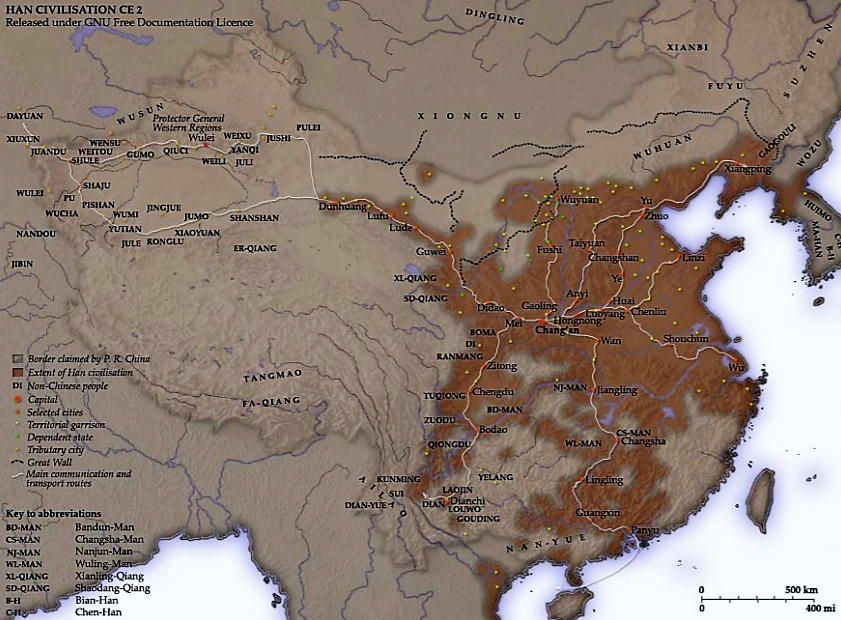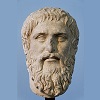4.9: The Han Dynasty, 202 BCE-220 CE
- Page ID
- 10771
After the First Emperor died in 210 BCE, the Qin Empire rapidly disintegrated. Historians debate causes but highlight weak successors manipulated by the intrigues of a high minister and court eunuch; excessive demands on the population for building projects, tax revenue, and military conscription; and a climate of fear created by the harshly punitive legal system. Regardless, by 207 BCE revolts were breaking out across the land, as rebels accrued armies, seized territory, and even declared themselves kings. China then fell into a state of civil war for five years until the intervention of Liu Bang [lee-oh bawng] (d. 195 BCE). A former farmer and village headman who rebelled and built an army and kingdom through his military acumen and charisma, Liu Bang defeated his adversaries and declared himself emperor of a new dynasty.
Government and Society during the Han Dynasty
The Han Dynasty, ruled by 24 successive emperors from the Liu imperial family, is normally divided into a Western Han (202 – 8 BCE) and Eastern Han (25 – 220 CE) because for a brief time an imperial in-law usurped the throne and established his own short-lived dynasty. This brief interregnum aside, the Han Dynasty lasted 400 years, making it second in length only to the Zhou Dynasty. So important was the Han to establishing a pattern in Chinese civilization distinguishing people belonging to it from those around them that Chinese people today refer to their ethnic group as Han Chinese. Also, after adopting the foundations laid by the Qin Dynasty, the Han further strengthened them, cementing an imperial pattern that persisted in China until the fall of the last dynasty (Qing) in 1911.
.png?revision=1&size=bestfit&width=747&height=551)
As opposed to studying a chronology of important events during these centuries, let’s consider the general picture for the political system and society of the Han Empire. The majority of people– as much as 90 percent of the population–were farmers, living out their lives in villages of a dozen to over 100 households. Some were independent farmers who owned small farms; some, tenants who leased land from owners of larger farms; and some, local magnates with large estates (see Figure \(\PageIndex{1}\)). The government relied heavily on the first group for revenue and conscription and therefore tried to keep these owner-farmers in business with low taxes, relief in times of hardship, and improvement in their agricultural methods. Unfortunately, over the course of the dynasty, many farmers fell on hard times and were forced to sell their land to powerful landlords, thus becoming their tenants or even slaves. Landlordism thus became a major social and political problem, as local great families dominated ever more dependent poor, undermining the central government’s revenue base.
The remaining ten percent of the population lived in urban areas–the towns and cities of Han China–as artisans and traders or officials and garrison soldiers. By some estimates, the total population during these centuries hovered at 60 million, which means about six million were urban residents. Many cities, such as the capitals of both the Western and Eastern Han, had over 100,000 residents (see Map \(\PageIndex{1}\)). The first imperial capital, Chang’an [chawng-an] (“Forever Peace”), was a walled city with twelve gates, watchtowers, market places, residential wards, administrative buildings and, of course, the imperial palace. Some of the agricultural produce, manufactured goods, and raw materials filling up the marketplaces testify to what artisans and traders were busy making, buying, and selling: cooked meats, pickled vegetables, fish, and grains; utensils and tools made of wood, brass, and iron; lacquer ware, jade, and furs; and textiles fashioned from silk and hemp. Imperial highways and lesser byways, and canals and other waterways, provided the routes for moving these goods both within and beyond China. Ever suspicious of the profit motive and believing in the foundational importance of the farmer, government officials supervised city markets and established agencies to regulate the most important industries.
.png?revision=1)
These commoner classes–farmers, artisans, and traders–were governed by a highly organized state and its corps of educated, professional civil servants. For administrative purposes, the empire was eventually divided into roughly 100 commanderies and 1300 counties. 130,000 officials constituted the bureaucracy. At the lowest level, working with village and town leaders, county magistrates handled such matters as tax collection, population registration, conscription for military service, law and order, and public works. They submitted reports to, and took orders from, commandery level military and civil officials, who then did the same with the nine ministries of the central government. These ministries handled such matters as revenue, justice, and foreign relations. The heads of each of these ministries, as well as two chancellors, routinely held audiences with the emperor to decide all policy matters. An independent branch of government, the censorate, audited the rest and reported directly to the emperor.
From the outset, the Han Dynasty inherited the Qin legalist system of government, with its emphasis on rational and efficient methods of administration and use of systems of rewards and punishments to promote order. However, early in the Han, Confucian scholars criticized Qin governing for lacking humaneness, and Han rulers increasingly saw the benefit of Confucian ideas to governing. This change was particularly the case with Emperor Wu [woo] (r. 141 – 87 BCE). During his reign, Confucius’s ideas were molded into an ideology that legitimated monarchy and a hierarchical social order. This ideology is called Imperial Confucianism. As an ideology, it simply provided a blueprint for how the political and social order should function.
.png?revision=1)
Rulers saw the benefit in having officials who were highly educated, loyal, of good character, and who understood the formalities of ritual and etiquette. An Imperial Academy was founded at the capital in 124 so that students could be educated in classical Confucian texts, including the Analects. Across the country, these students were nominated by local officials based on their learnedness and virtuous conduct. Successful graduates went on to serve as officials, and, because that conferred the highest prestige and status on an individual in Han China, Confucian values penetrated society. Texts were compiled explaining good etiquette, conduct, and ritual requirements for each family member and members of society based on their superior or subordinate status. Filial piety was celebrated in both art and texts (see Figure \(\PageIndex{2}\)), and law codes reinforced social norms by, for example, supporting the authority of the family patriarch, division of property among sons, and arranged marriages. In brief, over the course of the Han Dynasty, Chinese increasingly identified themselves as defenders of a Confucian civilization.
The emperor was at the pinnacle of both Han society and the political system, while the imperial family and in-laws constituted a privileged aristocracy. The emperor’s authority derived in theory from his having received the mandate of Heaven, his virtue, and his role as mediator between the celestial realms and human world; as such, he could expect his subjects’ obedience and loyalty. He resided within the walls of the imperial palace at the capital city, attended by eunuchs who handled his personal needs, palace administration, and the imperial harem. Emperors had numerous consorts but also a principal wife–the empress–who held a special status and was quite influential, usually because she bore the heir to the throne, but also because she and her in-laws were an intimate part of the emperor’s palace life. Often, the imperial family, imperial in-laws, eunuchs, and high officials broke apart into squabbling factions fighting for power and influence; this contention had deleterious consequences for the smooth functioning of the political system.
China and the Outer World during the Han Dynasty
Strengthened by its ever more confident political system and society, Han China also became an expansive empire, occupying and colonizing territory all along its borders. Sometimes this process was gradual: as migrants and merchants moved into neighboring areas, the government followed by setting up garrisons to protect them and eventually counties with civil servants to govern them. In other cases, armies were sent to subdue unstable borders or to secure trade routes. Regardless, as the dominant power in the region, China’s actions profoundly influenced and shaped the history of peoples and states in neighboring areas of Central and East Asia.
Traditionally, the biggest threats to the settled agricultural population of China came from non-Chinese nomadic pastoralists scattered about the steppe lands along the northern border (see Chapter Ten). These skilled horsemen and hunters tended their herds from horseback, resided in mobile campsites made up of yurts, and organized as tribes. These tribes usually selected the most skilled male warriors as their chieftains and also periodically organized into confederations so as to raid Chinese villages and towns (see Chapter Ten). During the Han, the most threatening confederation was knit together by Xiongnu [she-ong-new] (see Map \(\PageIndex{1}\)). The founding emperor, Liu Bang, sought to subdue them with his armies but was defeated and forced to pay tribute and offer imperial princesses in marriage to their chieftains. Emperor Wu, however, enjoying a stronger government, sent massive armies of over 100,000 soldiers campaigning deep into Xiongnu territory, breaking up their confederation and forcing them to relocate. Although his armies suffered great losses, Emperor Wu established garrisons across the northern border to consolidate his gains and protect China.
As Emperor Wu brought the Xiongnu under control, he became curious about Central Asian territories lying to the west of China. Interested in finding allies that might support him in his efforts to control nomad confederations, he sent envoys on exploratory missions. They returned with news of trade routes extending from oasis city-states ringing the forbidding deserts of the Taklamakan Desert to countries lying beyond the Pamir Mountains. What they were speaking of were the earliest Silk Roads (see Map \(\PageIndex{2}\)). Merchants had been using camels to carry such goods as silk from China to distant civilizations while bringing back gold, horses, and various handicrafts and foodstuffs. For that reason, beginning in 104 BCE, Emperor Wu dispatched armies to subdue the region as far as the Pamir Mountains, making the Han Dynasty overlords to Central Asian states, which were now obligated to send tribute and hostages. A frontier network of walls and watchtowers was then extended partway into the region. The Silk Roads were thus secured, and, because it could be conducted more safely, the volume of traffic grew. During the Han Dynasty, China demonstrated its intention of being a dominant player in Central Asia.
.png?revision=1&size=bestfit&width=779&height=441)
Conclusion: The Han Dynasty and Empires in History
These are some of the outstanding features of the Han Empire, and ones that can also be compared to other empires that existed at this time in other parts of the world, such as Mauryan Empire in India, Persian Empire in the Middle East, or Roman Empire. Each empire conferred a special status on rulers, had an organized imperial administration with an educated civil service, maintained a large army to defend an expanding and increasingly well-defined territory, and developed an ideology and legal codes that justified authority and reinforced social order. Confident in the superiority of their organized governments, powerful militaries, and worldview, each of these empires proceeded to extend control over neighboring states and peoples.


